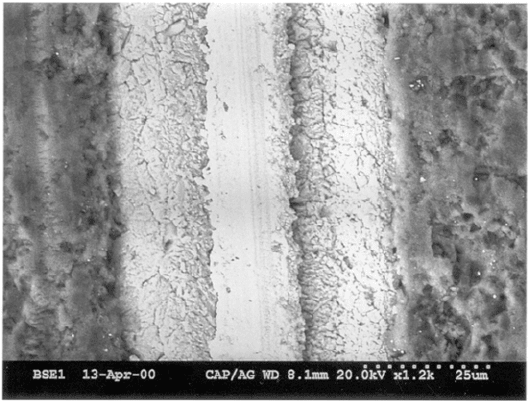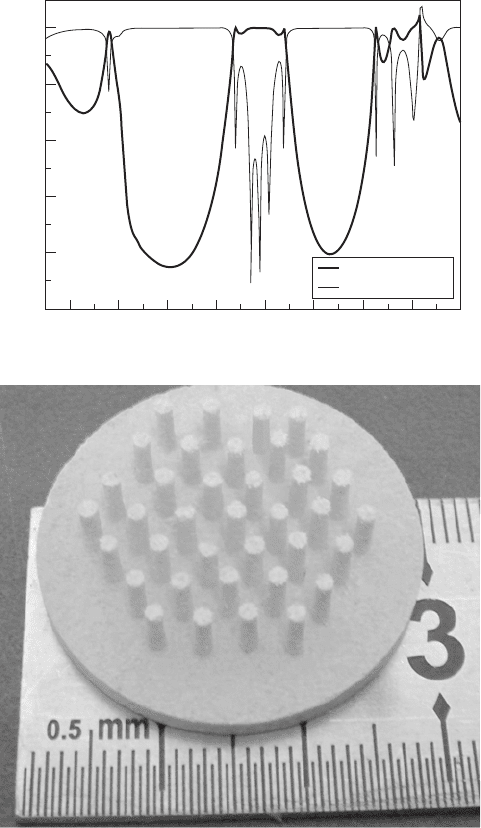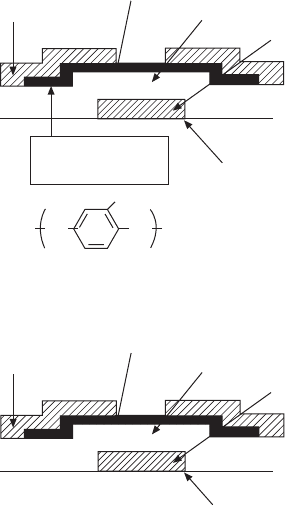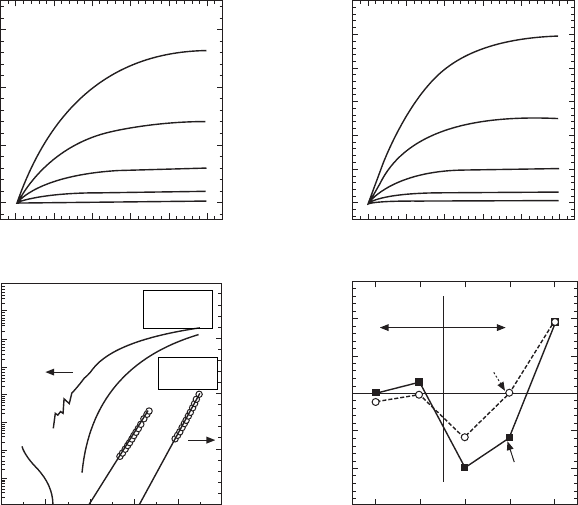Zuo-Guang. Ye Advanced Dielectric Piezoelectric and Ferroelectric Materials: Synthesis, Characterisation and Applications
Подождите немного. Документ загружается.


Handbook of dielectric, piezoelectric and ferroelectric materials530
17.12
Embedded capacitor in an LTCC structure (Randall
et al.
, 2003).
gap is greater than 60% of the gap center frequency, while the second gap is
25% of the center frequency (see Fig. 17.13). The interval between the two
gaps is larger than 2 GHz. The return loss of both gaps is as large as –40 dB.
This interesting multi-bandgap characteristic is very useful for diplexers,
multi-mode tunable dielectric antennas and resonators.
17.5.5 Applications as high-
K
dielectrics for
integrated circuit
With the trend of electronic devices development towards miniaturization,
the demand for high-K dielectrics in integrated circuits (IC) becomes more
and more imminent. The BZN dielectrics are very promising candidates for
being used as integrated dielectrics in IC, such as integrated capacitor, embedded
capacitors and gate insulator in thin film transistors, because of their high
dielectric constant and low dielectric loss.
Recently, J H Park et al. (2006) fabricated metal–insulator–metal (MIM)
thin film capacitors with Bi
1.5
ZnNb
1.5
O
7
(BZN) dielectric films. The BZN
thin films were deposited at room temperature by pulsed laser deposition
and annealed below 200 °C, which is compatible with the polymer-based
substrates. The BZN thin films although being amorphous still exhibit a high
capacitance density of 150nF/cm
2
and a low leakage current less than 1 µA/
cm
2
at 5V. These results show that the MIM structures using amorphous
BZN thin films will be a promising candidate for the PCB-embedded capacitors.
Bi
1.5
ZnNb
1.5
O
7
(BZN) dielectric films were also successfully prepared
via a room temperature process by PLD on polyimide substrates by Kim et
Commercial LTCC or Dupont 951
Ag electrode
Bi-pyrochlore dielectric
Ag electrode
Commercial LTCC or Dupont 951
WPNL2204

Bismuth-based pyrochlore dielectric ceramics 531
al. for the use as gate insulators in pentacene organic thin-film transistor
(OTFT) and ZnO thin film transistor (YW Choi et al., 2005; ID Kim et al.,
2005). Figure 17.14 shows the schematic cross-section of the OTFTs. The
OTFT and ZnO TFT devices exhibited very low operating voltages (<2 V
and <4 V, respectively) due to the high capacitance of the BZN dielectric
(Fig. 17.15). The high optical transparency (>80% for wavelength >400
S21 Simulated
S11 Simulated
468101214161820
Frequency (GHz)
(a)
S
Parameters (dB)
0
–10
–20
–30
–40
–50
(b)
17.13
Transmission and reflection coefficients (a) of a honeycomb
sample and (b) of 2D EBGs made of BZN dielectrics.
WPNL2204

Handbook of dielectric, piezoelectric and ferroelectric materials532
nm), low-temperature processing and low operating voltage of the TFT devices
with integrated BZN dielectric offer a promising route for the development
of transparent and flexible electronics.
17.6 Summary and future trends
With the rapid development of wireless hand-held devices, the needs for
passive component devices working in the high-frequency to microwave
range with enhanced reliability, miniaturization and electrical performance
are increasing fast. The motivation for the technological innovation is clearly
reflected in the ratio of passive components count to active integrated circuits,
40:1 in some wireless devices (Randall et al., 2003). This component count
ratio was predicted to increase as functionality of hand-held devices increases.
LTCC technology provides a good solution for integrating the passive
components as a functional module for microwave applications. The electrically
CH CH
n
Cl
Parylene C
(a)
SD (Au)
Active
(pentacene)
Gate insulator
(BZN)
Gate (Cr)
Substrate
(polyimide)
Thin parylene
(~2 nm)
SD (Au)
Active
(pentacene)
Gate insulator
(BZN)
Gate (Cr)
Substrate
(polyimide)
(b)
17.14
Schematic cross-section of the OTFTs with the stacked
parylene/BZN, threshold voltage –2.2 V, (a), and BZN only, threshold
voltage 0.1 V (b), gate dielectric (YW Choi
et al.
, 2005).
WPNL2204

Bismuth-based pyrochlore dielectric ceramics 533
steerable devices demand new dielectrics with high tunability and low dielectric
loss. The BZN cubic pyrochlore thin films exhibit high tunability, up to 55%,
with low dielectric loss, making them promising candidates for microwave
tunable devices. However, the electric bias field required for tuning in the
BZN thin films are still very high (2.4 MV/cm for a tunability of 55%) that
obstructs further practical application. The future R&D on bismuth-based
pyrochlores thus would be driven to further satisfy the potential application
demands. More efforts could be made to improve the fundamental
understanding of the structure and properties relation specifically to the
17.15
Drain current versus drain-to-source voltage curves at various
gate-to-source voltages for OTFT with parylene/BZN stacked gate
dielectric (a) and BZN only gate dielectric (b). Drain current and root
drain current versus gate-to-source voltage curve of OTFTs with BZN
only and parylene/BZN stacked gate dielectrics (c). Threshold
voltages of OTFTs with surface treatment of BZN and Al
2
O
3
gate
dielectrics before and after deposition of parylene film (d) (YW Choi
et al.
, 2005).
Drain current (µA)
–3
–2
–1
0
0 –1–2–3 –4–5
Drain voltage (V)
(a)
0–1–2–3–4–5
Drain voltage (V)
(b)
42 0–2–4–6
Gate voltage (V)
(c)
Stacked parylene/BZN, 200 nm
W/L
=2000 m/50 µm
V
g
=–5V
V
g
=–4V
V
g
=–3V
V
g
=–2V
V
g
=–1V
V
g
=0.1V
Drain current (µA)
–1.2
–1.0
–0.8
–0.6
–0.4
–0.2
0.0
V
g
=–2 V
V
g
=–1 V
V
g
=–0 V
V
g
=1
V
g
=2 V
BZN only, 20 nm
W/L
=2000 µm/50 µm
200 m,
V
ds
=–0.2 V
W/L
=2000 µm/50
µm
Without
paryfene
With
paryiene
Vth=-0.1V
Vth=-2.2V
Drain current (A)
10
–5
10
–6
10
–7
10
–8
10
–9
10
–10
10
–11
10
–12
10
–13
0.0020
0.0015
0.0010
0.0005
0.0000
Drain current (A)
1/2
Threshold voltage (V)
30
20
10
0
–10
–20
–30
BZN
200 nm
Al
2
O
2
150 nm
With
parylene
Without
parylene
Anneated BZN
As-deposited BZN
No treatment
Oxygen plasma
(HMDS) treatment
(d)
WPNL2204
Handbook of dielectric, piezoelectric and ferroelectric materials534
optical response (Zanetti et al., 2006), to explore new process routes (H
Wang et al., 2004a; Zanetti et al., 2004; Silva et al., 2005) to lower the cost
and improve the microwave dielectric properties, to investigate the co-firing
technology of bismuth-based dielectrics with Ag or Cu electrodes for LTCC
application, lowering the crystallization temperature of thin films (JG Chen
et al., 2005) and thick films to approach the semiconductor technology, and
to lower the bias field applied for tuning, so as to accelerate the applications
in microwave tunable devices.
17.7 Acknowledgements
The authors acknowledge the financial support by the National 973-project
of China under grant 2002CB613302, NSFC project of China under grant
50572085 and National 863-project of China under grant 2006AA03Z0429.
17.8 References
Cai X K et al. (1994a), ‘Formation mechanism of bismuth-zinc-niobium oxide pyrochlores’,
in Waser R, Proceedings of 4th International Conference on Electronic Ceramics &
Applications, Aachen, Germany, 147–151.
Cai X K et al. (1994b), ‘The preparation and structures of bismuth-based oxide and
oxyfluoride pyrochlores’, in Waser R, Proceedings of 4th International Conference on
Electronic Ceramics & Applications, Aachen, Germany, 152–154.
Cai X K et al. (1994c), ‘Synthesis and dielectric properties of new compounds with
pyrochlore type structure’, Ferroelectrics, 154, 319–324.
Cann D P et al. (1996), ‘Investigation of the dielectric properties of bismuth pyrochlores’,
Solid State Comm, 1100(7), 529–534.
Chen A et al. (2003), ‘Dielectric properties of Bi
2
O
3
–ZnO–Ta
2
O
5
pyrochlore and zirconolite
structure ceramics’, Appl Phys Lett, 82, 3734–3736.
Chen J G et al. (2005), ‘Low-temperature crystallized pyrochlore bismuth zinc niobate
thin films by excimer laser annealing’, Appl Phys Lett, 87, 232905.
Chen M et al. (1998), ‘High performance multiplayer ceramic capacitor with low sintering
temperatures’, J Korean Phys Soc, 32S, 1210–1213.
Chen M H et al. (2005), ‘Infrared study of the phonon modes in bismuth pyrochlore’,
Phys. Rev. B, 72, 054303.
Chen S Y et al. (2003), ‘Phase transformation, reaction kinetics and microwave characteristics
of Bi
2
O
3
–ZnO–Nb
2
O
5
ceramics’, J Euro Ceram Soc, 23, 873–881.
Cheng H-F et al. (2000), ‘Frequency response of microwave dielectric Bi
2
(Zn
1/3
Nb
2/3
)O
7
thin films laser deposited on indium–tin oxide coated glass’, J Appl Phys, 87 479–483.
Cheng H-F et al. (2003), ‘Full spectrum dielectric response of Bi
2
(Zn
1/3
Nb
2/3
)O
7
thin
films in teraherz, infrared and optical frequency regions’, Mater Chem Phys, 79, 161–
163.
Cheng H–F et al. (2004), ‘Correlation of microwave dielectric properties and crystallinity
for pulsed laser deposited Bi
2
(Zn
1/3
Nb
2/3
)
2
O
7
thin films’, J Euro Ceram Soc, 24,
1791–1794.
Choi G-K et al. (2004), ‘Influence of V
2
O
5
substitutions to Bi
2
(Zn
1/3
Nb
2/3
)O
7
pyrochlore
on sintering temperature and dielectric properties’, Ceram Int, 30, 1187–1190.
WPNL2204
Bismuth-based pyrochlore dielectric ceramics 535
Choi Y W et al. (2005), ‘Low-voltage organic transistors and depletion-load inverters
with high-k pyrochlore BZN gate dielectric on polymer substrate’, IEEE Trans. Electron
Devices, 52(12), 2819–2823.
Du H et al. (2001), ‘Electro-plating technology of high performance low sintering BZN
based MLC’, Ferroelectrics Lett, 28, 1–2.
Du H et al. (2002a), ‘Evolution of structure and dielectric properties on bismuth-based
pyrochlore with TiO
2
incorporation’, J Electroceramics, 9, 117–124.
Du H et al. (2002b), ‘Dielectric relaxation characteristics of bismuth zinc niobate pyrochlores
containing titanium’, Physica B, 324, 121–126.
Du H et al. (2003), ‘Effect of Sr substitution on dielectric characteristics in Bi
1.5
ZnNb
1.5
O
7
ceramics’, Mater Sci Eng B, 99, 437–440.
Du H et al. (2004a), ‘Observations on structural evolution and dielectric properties of
oxygen-deficient pyrochlores’, Ceramics International, 30, 1383–1287.
Du H et al. (2004b), ‘Structral trends and dielectric properties of Bi-based pyrochlores’,
J Mater Sci, 15, 613–616.
Du H et al. (2006), ‘Dielectric properties of pyrochlore (Bi
1.5
Zn
0.5
)(Nb
0.5
M
1.5
)O
7
(M= Ti,
Sn, Zr and Ce) dielectrics’, Appl Phys Lett, 88(21), 212901.
Fu W Y et al. (2006), ‘Dielectric properties of Bi
1.5
Zn
1.0
Nb
1.5
O
7
/Mn-doped Ba
0.6
Sr
0.4
TiO
3
heterolayered films grown by pulsed laser deposition’, Appl Phys Lett, 89, 132908.
Ha S et al. (2005), ‘The effect of substrate heating on the tunability of rf-sputtered Bi
2
O
3
–
ZnO–Nb
2
O
5
thin films’, Appl Phys A, 80, 585–590.
Hong Y P et al. (2002), ‘Voltage tunable dielectric properties of rf sputtered Bi
2
O
3
–ZnO–
Nb
2
O
5
pyrochlore thin films’, Thin Solid Films, 419, 83–188.
Jiang S W et al. (2006), ‘Laser deposition and dielectric properties of cubic pyrochlore
bismuth zinc niobate thin films’, J Vac Sci Technol A, 24(2), 261–263.
Kamba S et al. (2002), ‘Anomalous broad dielectric relaxation in Bi
1.5
Zn
1.0
Nb
1.5
O
7
pyrochlore’, Phys Rev B, 66, 054106.
Khaw C C et al. (2007), ‘Pyrochlore phase formation in the system Bi
2
O
3
–ZnO–Ta
2
O
5
’,
J Am Ceram Soc, 90 (9), 2900–2904.
Kim I D et al. (2005), ‘Low-voltage ZnO thin-film transistors with high-K Bi
1.5
Zn
1.0
Nb
1.5
O
7
gate insulator for transparent and flexible electronics’, Appl Phys Lett, 87, 043509.
Kim J S et al. (2002), ‘Phase relation and dielectric properties of Bi
2
O
3
–ZnO–Nb
2
O
5
–
based ceramics’, Ferroelectrics, 272, 273–278.
Kim J Y et al. (2005), ‘Voltage-tunable dielectric properties of pyrochlore Bi–Zn–Nb–Ti–
O solid solution thin films’, Jpn J Appl Phys, 44, 6648–6653.
Kim S S et al. (2005), ‘Electrical properties of sol–gel derived pyrochlore-type bismuth
magnesium niobate Bi
2
(Mg
1/3
Nb
2/3
)
2
O
7
thin films’, J Crys Growth, 281, 432–439.
Ko K H et al. (2005), ‘Phase decomposition and dielectric properties of reactively sputtered
bismuth zinc niobate pyrochlore thin films deposited from monoclinic zirconolite
target’, J Electroceramics, 14, 171–175.
Lee Y C et al. (2006), ‘Very high tunable inter-digital capacitor using bismuth zinc
niobate thin-film dielectrics for microwave applications’, Electronics Lett., 42(15),
851–853.
Levin I et al. (2002a), ‘Structural study of an unusual cubic pyrochlore Bi
1.5
Zn
0.92
Nb
1.5
O
6.92
’,
J Solid State Chem, 168, 69–75.
Levin I et al. (2002b), ‘Crystal structure of the compound Bi
2
Zn
2/3
Nb
4/3
O
7
’, J Mater Res,
17(6), 1406–1411.
Li B Y et al. (1986), Inorganic Dielectric Materials (in Chinese), Shanghai, Shanghai
Science and Technology Press, 1986.
WPNL2204
Handbook of dielectric, piezoelectric and ferroelectric materials536
Ling H C et al. (1990), ‘High dielectric constant and small temperature coefficient bismuth-
based dielectric compositions’, J Mater Res, 5(8), 1752–1762.
Liu D H et al. (1993), ‘Phase structure and dielectric properties of Bi
2
O
3
–ZnO–Nb
2
O
5
–
based dielectric ceramics’, J Am Ceram Soc, 76(8), 2129–2132.
Liu Y et al. (2006), ‘Crystal chemistry on a lattice: the case of BZN and BZN–related
pyrochlores’, J Solid State Chem, 179, 2141–2149.
Liu Y et al. (2007), ‘Direct observation of structural disordering of BZN-based pyrochlores’,
J Electroceramics, published online.
Lu J et al. (2003a) , ‘Low-loss, tunable bismuth zinc niobate films deposited by rf
magnetron sputtering’, Appl Phys Lett, 83, 2411–2413.
Lu J et al. (2003b), ‘Composition control and dielectric properties of bismuth zinc niobate
thin films synthesized by radio-frequency magnetron sputtering’, J Vac Sci Technol,
21(5) 2855–2862.
Lu J et al. (2004), ‘Influence of strain on the dielectric relaxation of pyrochlore bismuth
zinc niobate thin films’, Appl Phys Lett, 84, 957–959.
Lu J et al. (2006), ‘Low-loss tunable capacitors fabricated directly on gold bottom electrodes’,
Appl Phys Lett, 88, 112905.
Melot B et al. (2006), ‘Displacive disorder in three high-k bismuth oxide pyrochlores’,
Mater Res Bull, 41, 961–966.
Mergen A et al. (1996), ‘Fabrication and crystal chemistry of Bi
3/2
ZnSb
3/2
O
7
pyrochlore’,
J Euro Ceram Soc, 16, 1041–1050.
Mergen A et al. (1997), ‘Crystal chemistry, thermal expansion and dielectric properties of
(Bi
1.5
Zn
0.5
)(Sb
1.5
Zn
0.5
)O
7
pyrochlore’, Mater Res Bull, 32(2), 175–189.
Miles G C et al. (2006), West A R, ‘Pyrochlore phases in the system ZnO–Bi
2
O
3
–Sb
2
O
5
:
I. Stoichiometries and phase equilibria’, J Am Ceram Soc, 89(3), 1042–1046.
Nino J C et al. (2001a), ‘Dielectric relaxation in Bi
2
O
3
–ZnO–Nb
2
O
5
cubic pyrochlore’,
J Appl Phys, 89, 4512–4516.
Nino J C et al. (2001b), ‘Phase formation and reactions in the Bi
2
O
3
–ZnO–Nb
2
O
5
–Ag
pyrochlore system’, J Mater Res, 16(5), 1460–1464.
Nino J C et al. (2002), ‘Correlation between infrared modes and dielectric relaxation in
Bi
2
O
3
–ZnO–Nb
2
O
5
cubic pyrochlore’, Appl Phys Lett, 23, 4404–4406.
Okaura S et al. (2005), ‘MOCVD growth of Bi
1.5
Zn
1.0
Nb
1.5
O
7
(BZN) epitaxial thin films
and their electrical properties’, Jpn J Appl Phys, 44, 6957–6959.
Park J et al. (2005), ‘Microwave dielectric properties of tunable capacitors employing
bismuth zinc niobate thin films’, J Appl Phys, 97, 084110.
Park J et al. (2006), ‘Distributed phase shifter with pyrochlore bismuth zinc niobate thin
films’, IEEE Microwave and Wireless Components Letters, 5, 264–266.
Park J-H et al. (2006), ‘Bismuth–zinc–niobate embedded capacitors grown at room
temperature for printed circuit board applications’, Appl. Phys. Lett., 88, 192902.
Peng D et al. (2004), ‘Study on relationship between sintering atmosphere and dielectric
properties for Bi
2
O
3
–ZnO–Ta
2
O
5
system’, Ceram Int, 30, 1199–1202.
Peng Z et al. (2004), ‘Dielectric resonator antennas using high permittivity ceramics’,
Ceram. Int., 30, 1211–1214.
Randall C A et al. (2003), ‘Bi-pyrochlore and zirconolite dielectrics for integrated passive
component applications’, Am Ceram Soc Bull, 11, 9103–9108.
Ren W et al. (2001), ‘Bismuth zinc niobate pyrochlore dielectric thin films for capacitive
applications’, J Appl Phys, 89, 767–774.
Shen B et al. (2004), ‘Structure and dielectric properties of Bi
2
O
3
–ZnO–CaO–Ta
2
O
5
ceramics’, Ceram Int, 30, 1207–1210.
WPNL2204
Bismuth-based pyrochlore dielectric ceramics 537
Shen B et al. (2005), ‘Dielectric relaxation and tunability of Bi
2
O
3
–ZnO–CaO–Ta
2
O
5
ceramics’, Appl Phys Lett, 86, 072902.
Shi J Z et al. (2007), ‘Fabrication of 2–D EBGs by moulding/demoulding with high
dielectric constant ceramic and their properties’, J. Electroceramics, published online.
Silva S A et al. (2005), ‘Bismuth zinc niobate pyrochlore Bi
1.5
ZnNb
1.5
O
7
from a polymeric
urea-containing precusor’, Mater Chem Phys, 93, 521–525.
Sirotinkin V P et al. (2003), ‘Preparation and dielectric properties of Bi
1.5
MNb
1.5
O
7
(M
= Cu, Mg, Mn, Ni, Zn) pyrochlore oxides’, Inorg Mater, 39(9), 054303.
Somphon W et al. (2006), ‘Local crystal chemistry, structured diffuse scattering and
dielectric properties of (Bi
1–x
Y
x
)(M
III
Nb
V
)O
7
(M=Fe
3+
, In
3+
) Bi-pyrochlores’, J Solid
State Chem, 179, 2495–2505.
Su W-F et al. (2003), ‘Interfacial behaviour between Bi
1.5
ZnNb
1.5
O
7
•0.02V
2
O
5
and Ag’,
J Euro Ceram Soc, 23, 2593–2596.
Subramanian M A (1983), ‘Oxide pyrochlore – a review’, Prog Solid State Chem, 15, 55–
143.
Tagantsev A K et al. (2005), ‘Temperature dependence of the dielectric tunability of
pyrochlore bismuth zinc niobate thin films’, Appl Phys Lett, 86, 032901.
Tan K B et al. (2005), ‘Stoichiometry and doping mechanism of the cubic pyrochlore
phase in the system Bi
2
O
3
–ZnO–Nb
2
O
5
’, J Mater Chem, 15, 3501–3506.
Thayer R L et al. (2003), ‘Medium permittivity bismuth zinc niobate thin film capacitors’,
J Appl Phys, 94, 1941–1946.
Tian H Y et al. (2006), ‘Dielectric properties and abnormal C–V characteristics of
Ba
0.5
Sr
0.5
TiO
3
–Bi
1.5
ZnNb
1.5
O
7
composite thin films grown on MgO (001) substrates
by pulsed laser deposition’, Appl Phys Lett, 89(14), 142905.
Valant M et al. (1999), ‘Synthesis and dielectric properties of pyrochlore solid solutions
in the Bi
2
O
3
–ZnO–Nb
2
O
5
–TiO
2
system’, J Mater Sci, 34, 5437–5442.
Valant M et al. (2000), ‘Crystal chemistry and dielectric properties of chemically substituted
(Bi
1.5
Zn
1.0
Nb
1.5
)O
7
and Bi
2
(Zn
2/3
Nb
4/3
)O
7
pyrochlores’, J Am Ceram Soc, 83(1), 147–
153.
Valant M et al. (2005), ‘The Bi
2
O
3
–Nb
2
O
5
–NiO phase diagram’, J Am Ceram Soc, 88(9),
2540–2543.
Vanderah T A et al. (2005), ‘An unexpected crystal-chemical principle for the pyrochlore
structure’, Eur J Inorg Chem, 2895–2901.
Wang H et al. (1994a), ‘Effect of Bi
2
O
3
and sintering temperature on pyrochlore structure
in the Bi
2
O
3
–ZnO–Nb
2
O
5
system’, in Waser R, Proceedings of 4th International
Conference on Electronic Ceramics & Applications, Aachen, Germany, 139–142.
Wang H et al. (1994b), ‘Structural study of cubic pyrochlore in the Bi
2
O
3
–ZnO–Nb
2
O
5
system’, in Waser R, Proceedings of 4th International Conference on Electronic Ceramics
& Applications, Aachen, Germany, 143–146.
Wang H et al. (1995), ‘Cubic pyrochlore structure in the Bi
2
O
3
–ZnO–Nb
2
O
5
system’, J
Chin Ceram Soc (in Chinese), 23(3) 241–247.
Wang H et al. (1996a), ‘Phase transformation and phase distribution of pyrochlore structure
in Bi
2
O
3
–ZnO–Nb
2
O
5
system’, Proceedings of 10th IEEE International Symposium
on Applications of Ferroelectrics, East Brunswick, USA, 787–790.
Wang H et al. (1996), ‘Preparation, structure and dielectric properties of bismuth-based
ceramic dielectrics’, Proceedings of 9
th
IEEE International Symposium on Electrets,
Shanghai, China, 1024–1029.
Wang H et al. (1997), ‘Phase equilibrium in Bi
2
O
3
–ZnO–Nb
2
O
5
system’, Ferroelectrics,
195, 19–22.
WPNL2204
Handbook of dielectric, piezoelectric and ferroelectric materials538
Wang H (1998), ‘Structure, phase relations and dielectric properties of Bi
2
O
3
–ZnO–
Nb
2
O
5
based ceramics’, PhD Thesis, Xi’an Jiaotong University.
Wang H et al. (1999a), ‘Phase transition of pyrochlore structure in Bi
2
O
3
–ZnO–Nb
2
O
5
system’, Ferroelectrics, 229, 95–101.
Wang H et al. (1999b), ‘Effect of La
2
O
3
substitution on structure and properties of
Bi
2
O
3
–ZnO–Nb
2
O
5
based pyrochlore ceramics’, J Mater Res, 14(2), 546–548.
Wang H et al. (2001a), ‘Structure study of a new distorted pyrochlore in Bi
2
O
3
–ZnO–
Nb
2
O
5
system’, Ferroelectrics, 262, 71–76.
Wang H et al. (2001b), ‘Melting behaviors of pyrochlores in Bi
2
O
3
–ZnO–Nb
2
O
5
system’,
Ferroelectrics, 261, 225–231.
Wang H et al. (2003), ‘Structural study of Bi
2
O
3
–ZnO–Nb
2
O
5
based pyrochlores’, Mater
Sci & Eng B, 99, 20–24.
Wang H et al. (2004a), ‘Bismuth zinc niobate (Bi
1.5
ZnNb
1.5
O
7
) ceramics derived from
metallo-organic decomposition precursor solution’, Solid State Comm, 132, 481–486.
Wang H et al. (2004b), ‘Mn
4+
and W
6+
substitution on Bi
2
O
3
–ZnO–Nb
2
O
5
–based low
firing ceramics’, Ceram Int, 30, 1219–1223.
Wang H et al. (2004c), ‘Improvements of sintering and dielectric properties on Bi
2
O
3
–
ZnO–Nb
2
O
5
pyrochlore ceramics by V
2
O
5
substitution’, Ceram Int, 30, 1225–1229.
Wang H et al. (2006a), ‘Microwave dielectric relaxation in cubic bismuth-based pyrochlores
containing Titanium’, J Appl Phys, 100, 014105.
Wang H et al. (2006b), ‘Microwave and infrared dielectric response of monoclinic Bismuth
Zinc Niobate based pyrochlore ceramics with ion substitution in A site’, J Appl Phys,
100, 034109.
Wang X L et al. (1997), ‘Structure, phase transformation and dielectric properties of
pyrochlores containing bismuth’, J Am Ceram Soc, 80(10), 2745–2748.
Wang Z P et al. (1985), ‘Lead free low firing MLCC dielectric materials’, Electronic
Components & Materials (in Chinese), 1, 383–389.
Withers R L et al. (2004), ‘Local crystal chemistry, induced strain and short range order
in the cubic pyrochlore (Bi
1.5–α
Zn
0.5–β
)(Zn
0.5–γ
Nb
1.5–δ
)O
7–1.5α–β–γ–2.5δ
(BZN)’, J Solid
State Chem, 177, 231–244.
Yan L et al. (2004), ‘Ba
0.5
Sr
0.5
TiO
3
–Bi
1.5
Zn
1.0
Nb
1.5
O
7
composite thin films with promising
microwave dielectric properties for microwave devices applications’, Appl Phys Lett,
85, 3522–3524.
Yan M F et al. (1990), ‘Low-firing, temperature-stable dielectric compositions based on
bismuth nickel zinc niobates’, J Am Ceram Soc, 72(4), 1106–1107.
Yee K A et al. (1999), ‘The effect of V
2
O
5
on the sintability and physical properties of
Bi
2
O
3
–NiO–Nb
2
O
5
and Bi
2
O
3
–ZnO–Nb
2
O
5
temperature–stable dielectrics’, J Mater
Sci, 34, 4699–4704.
Youn H-J et al. (2002), ‘Dielectric relaxation and microwave dielectric properties of
Bi
2
O
3
–ZnO–Ta
2
O
5
ceramics’, J Mater Res, 17(6), 1502–1506.
Zhou D et al. (2007), ‘The two element antennas using high permittivity bismuth-based
ceramics’, submitted to Mater & Sci Eng A. published online.
Zanetti S M et al. (2004), ‘A chemical route for the synthesis of cubic bismuth zinc
niobate pyrochlore nanopowders’, J Solid State Chem, 177, 4564–4551.
Zanetti S M et al. (2006), ‘Structural and optical properties of Bi
1.5
ZnNb
1.5
O
7
pyrochlore
thin films prepared by chemical method’, Thin Solid Films, 497, 72–76.
WPNL2204

Part V
Nanoscale piezo- and ferroelectrics
539
WPNL2204
